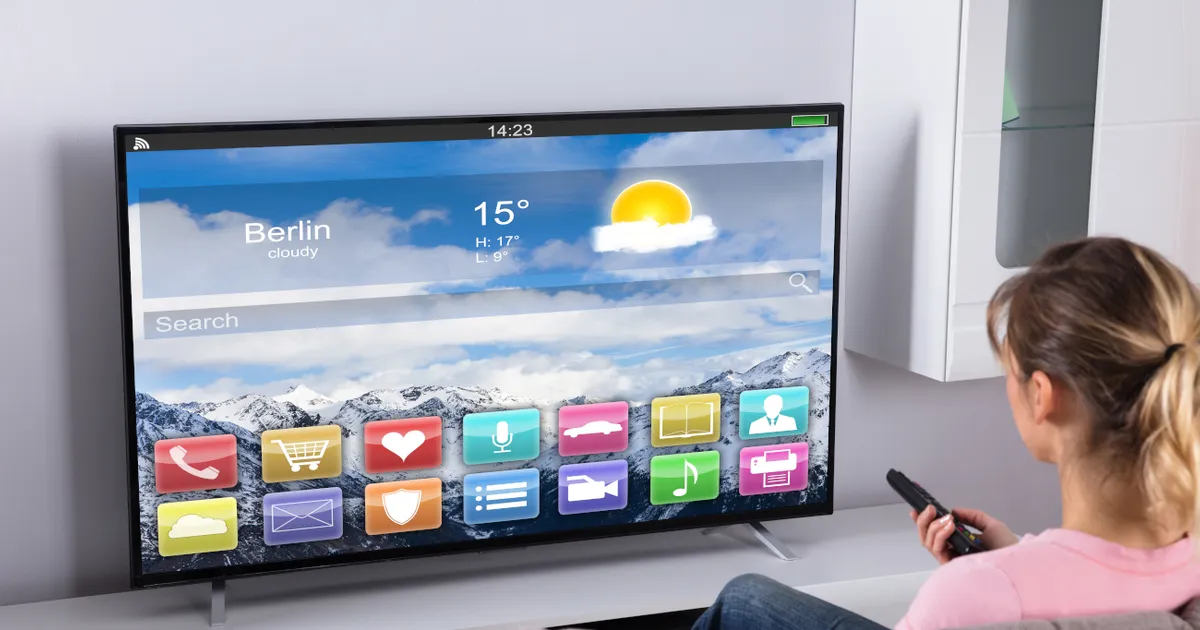When it comes to purchasing a new Smart TV, there are several important considerations to keep in mind. From screen size and picture quality to Smart TV features and connectivity options, there are many factors to consider.
By taking the time to carefully evaluate your options and choose a TV that’s right for you, you can enjoy an immersive and enjoyable viewing experience that meets your entertainment needs. Start a search today to find the best Smart TVs.
 Shutterstock: Andrey_Popov
Shutterstock: Andrey_PopovSmart TV Features
Surely you’re purchasing a Smart TV for its cutting-edge features, so let’s dive in! One of the most important Smart TV features is the availability of streaming apps, such as Netflix, Amazon Prime Video, and HBO Max. This way, you can easily stream your favorite movies and TV shows without needing a separate streaming device.
It’s also wise to consider compatibility with other smart devices you may have in your smart home ecosystem, such as smart speakers or smart lights. This can provide added convenience and flexibility for controlling your home entertainment system.
Screen Size
When selecting a screen size, consider the size of the room and the distance from the TV. A general rule of thumb is that the distance from the TV should be at least twice the diagonal length of the screen. For example, if you have a 50-inch screen, you should sit at least 100 inches (or 8.3 feet) away from the TV.
Another factor to consider is the aspect ratio of the screen, which refers to the ratio of the width to the height. 1 Most Smart TVs have a 16:9 aspect ratio, which is the standard for high-definition content. However, if you love watching VHS movies and old TV shows that may have a different aspect ratio, you’ll be forced to look at black bars on the top and bottom of the screen.
A screen that’s too small may make it difficult to see details, while a screen that’s too large may cause eye strain or discomfort. For many people, screen size is the only criteria when deciding which TV to purchase. And while it is a major consideration, it’s far from the only one!
Picture Quality
There are several aspects of picture quality you’ll want to keep in mind, ranging from resolution and brightness to contrast. A higher resolution, such as 4K or 8K, provides more pixels and a more detailed image. 2 High brightness and contrast can produce a more realistic and dynamic image.
Other factors that can impact picture quality include color accuracy, motion handling, and upscaling technology. By choosing a TV with a high-quality picture, you can enjoy a more immersive and enjoyable viewing experience.
Sound Quality
While sound quality always comes secondary to picture quality, it’s a major component when watching a jaw-dropping movie or sporting event. Be sure to consider the number of speakers, the wattage, and the audio technology.
TVs with multiple speakers, such as soundbars or subwoofers, can provide more immersive and dynamic audio than TVs with only one or two speakers. Audio technology, meanwhile, can impact the quality and clarity of the audio. Look for a TV with advanced audio technologies, such as Dolby Atmos or DTS:X, which can provide a more realistic audio experience.
Connectivity
A TV with a variety of connectivity options, including wireless and Wi-Fi capabilities, can provide more flexibility for accessing and sharing content. Multiple HDMI ports will ensure that you can connect gaming consoles, Blu-ray players, or streaming units to your TV. 3
Likewise, the availability of USB ports is essential if you plan on connecting external hard drives, flash drives, or other storage devices. This can make it easier to access and play media files directly on the TV without needing to use a separate device.
Privacy
Smart TVs are equipped with microphones that allow for voice control and voice search functions. However, this has raised concerns about whether Smart TVs can listen to and record conversations that are had in its vicinity.
There have been instances where Smart TVs have been found to collect and transmit audio data without the user’s knowledge or consent. To protect your privacy, it’s recommended to review the privacy settings of your Smart TV and disable any features that may record or transmit audio data.
Brand and Warranty
Choose a reputable brand with a good reputation for quality and customer service. This research can be done with a quick online search of consumer reports and reviews.
A good warranty can provide protection and peace of mind. Look for a warranty that provides sufficient coverage, including protection against defects and malfunctions.
Average Costs
The cost of Smart TVs can range from a few hundred dollars to several thousand dollars, depending on the features and quality that you require. Major retailers frequently discount Smart TVs in their promotions, or use them as door-crashers during holiday sales.
The average price of a 55-inch smart TV runs between $350 to $1,600, according to Consumer Reports. 4 Smaller televisions in the 39-inch to 43-inch size bracket can cost between $220 and $1,200. Meanwhile, 65-inch sets can run between $450 and $2,600.
Screen size can determine price to a degree, but by and large, you’re paying for performance. So, it’s important to research the available high-definition options and, if possible, see how much resolution is enough for your viewing needs.
Peace of Mind is Valuable
When shopping for a smart TV, keep these important factors in mind to ensure that you get the best possible viewing experience. It’s also important to set a budget and compare prices across different brands and retailers.
A well-informed decision will not only provide you with a TV that performs better, but it will also give you peace of mind knowing that you’ve made a sound investment. Ultimately, researching your Smart TV options and understanding your preferences will score you a TV that entertains you for years to come!
